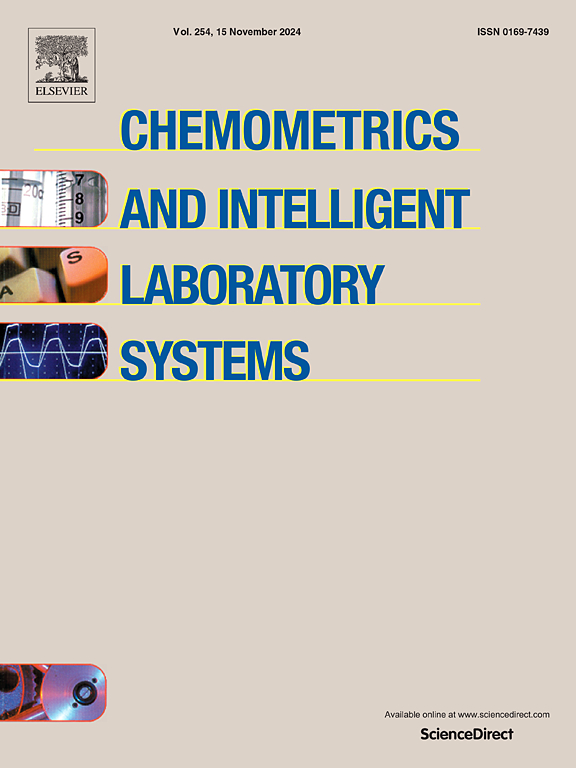VAE-SIMCA — Data-driven method for building one class classifiers with variational autoencoders
IF 3.7
2区 化学
Q2 AUTOMATION & CONTROL SYSTEMS
Chemometrics and Intelligent Laboratory Systems
Pub Date : 2024-11-19
DOI:10.1016/j.chemolab.2024.105276
引用次数: 0
Abstract
The paper proposes a new method for building one class classifiers based on variational autoencoders (VAE). The classification decision is built on a linear combination of two squared distances: computed for the original and the reconstructed image as well as for the representation of the original image inside the latent space formed by VAE. Because both distances are well approximated by scaled chi-square distribution, the decision boundary is computed using the theoretical quantile function for this distribution and the predefined probability for Type I error, ⍺. Thereby the boundary does not require any specific optimization and is solely based on the model outcomes computed for the training set.
The original idea of the proposed method is inherited from another OCC approach, Data Driven Soft Independent Method for Class Analogies, where singular value decomposition is employed for building the latent space. In this paper we show how this idea can be adopted to be used with VAE for detection of anomalies on images. The paper describes the theoretical background, introduces the main outcomes as well as tools for visual exploration of the classification results, and shows how the method works on several simulated and real datasets.
VAE-SIMCA - 利用变异自动编码器构建一类分类器的数据驱动方法
本文提出了一种基于变异自动编码器(VAE)建立一类分类器的新方法。分类决策建立在两个平方距离的线性组合上:计算原始图像和重建图像的平方距离,以及原始图像在 VAE 形成的潜空间内的表示平方距离。由于这两个距离都能很好地近似于按比例的奇平方分布,因此决策边界是使用该分布的理论量子函数和预定义的 I 类错误概率⍺来计算的。因此,边界不需要任何特定的优化,只需根据训练集计算出的模型结果来确定。本文提出的方法的原始思想继承自另一种 OCC 方法,即类类比的数据驱动软独立方法(Data Driven Soft Independent Method for Class Analogies),该方法采用奇异值分解来构建潜在空间。在本文中,我们展示了如何将这一想法与 VAE 一起用于图像异常检测。本文描述了理论背景,介绍了主要成果以及可视化探索分类结果的工具,并展示了该方法如何在多个模拟和真实数据集上运行。
本文章由计算机程序翻译,如有差异,请以英文原文为准。
求助全文
约1分钟内获得全文
求助全文
来源期刊
CiteScore
7.50
自引率
7.70%
发文量
169
审稿时长
3.4 months
期刊介绍:
Chemometrics and Intelligent Laboratory Systems publishes original research papers, short communications, reviews, tutorials and Original Software Publications reporting on development of novel statistical, mathematical, or computer techniques in Chemistry and related disciplines.
Chemometrics is the chemical discipline that uses mathematical and statistical methods to design or select optimal procedures and experiments, and to provide maximum chemical information by analysing chemical data.
The journal deals with the following topics:
1) Development of new statistical, mathematical and chemometrical methods for Chemistry and related fields (Environmental Chemistry, Biochemistry, Toxicology, System Biology, -Omics, etc.)
2) Novel applications of chemometrics to all branches of Chemistry and related fields (typical domains of interest are: process data analysis, experimental design, data mining, signal processing, supervised modelling, decision making, robust statistics, mixture analysis, multivariate calibration etc.) Routine applications of established chemometrical techniques will not be considered.
3) Development of new software that provides novel tools or truly advances the use of chemometrical methods.
4) Well characterized data sets to test performance for the new methods and software.
The journal complies with International Committee of Medical Journal Editors'' Uniform requirements for manuscripts.

 求助内容:
求助内容: 应助结果提醒方式:
应助结果提醒方式:


